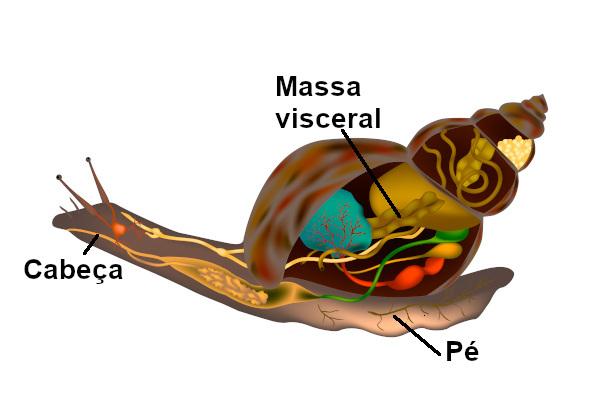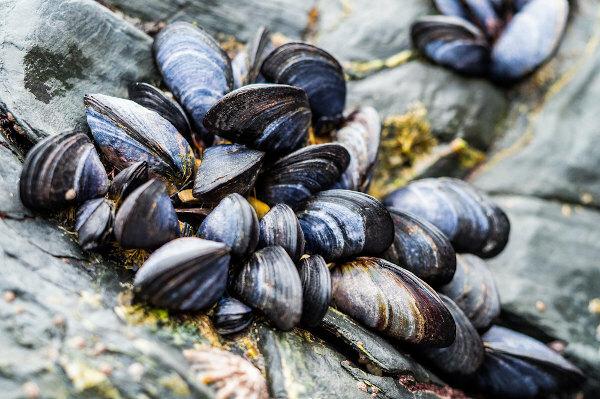Molluscs (Phylum mollusk)they are animals which have the soft body as a striking feature. In many representatives, this body can be protected by a shell, as in the case of the snail and the snail. Most of its representatives are marine, but there are species living in fresh water and in the terrestrial environment.
They constitute the second largest phylum of invertebrates, second only to the arthropods. There are more than 100,000 known species, with representatives such as squids, octopuses, oysters, slugs, among others. They are economically important, as they are widely used in food.
Read too: African Giant Snail - characteristics and diseases it transmits
General characteristics of molluscs
molluscs are animals invertebrates, triblasts (have three embryonic leaflets: endoderm, mesoderm and ectoderm), coelomate (they have a body cavity, lined with tissue derived from the mesoderm, called the coelom), with bilateral symmetry, and protostomes (The blastopore gives rise to the mouth).
Molluscs stand out for having a soft body and, in most cases, with the presence of a protective shell. In some species, the presence of the shell is not observed, as in slugs and octopuses. In squid, the shell is reduced and internal.
The body of all molluscs has a basic division:
- Foot: assists the animal in moving, fixing and excavating.
- Visceral mass: portion of the mollusc body in which the internal organs are located.
- Cloak: fold of tissue that covers the visceral mass and is responsible for secreting the shell in animals where it may be. In some species, the mantle forms the so-called mantle cavity, where the gills lodge and the digestive, excretory and genital systems open.

O digestive system is complete, showing mouth and anus. In some species, the presence of radula, a sort of scraping tongue full of curved chitinous teeth. Different eating habits are observed in molluscs, existing species herbivores, carnivores, that feed on suspended material,among other habits.
Do not stop now... There's more after the advertising ;)
The circulatory system of these animals is open, with except for cephalopods, they have it closed. This means that, in most molluscs, hemolymph flows into vessels and then is released into gaps in the body. Molluscs have a heart that pumps the hemolymph.
With regard to gas exchange, different structures are observed. In aquatic molluscs, the presence of gills, and, in terrestrials, one can observe the mantle cavity functioning as a rudimentary lung. Also, there are species with cutaneous breathing.
Excretion is carried out by organs called metanephrides. O nervous system of these animals consists of a nerve ring around the esophagus, from which two pairs of nerve cords depart. present different Sensory organs, like eyes and tentacles. It is noteworthy that, in cephalopods, the eyes are well developed.
Read more: Gill respiration - ensures that aquatic animals remove oxygen from the water
Reproduction of molluscs
Most molluscs have separate sexes, that is, they have male and female. In these animals the structures producing gametes (ovaries and testes) are located in the visceral mass. There are still species hermaphrodites, like some species of snails.

Depending on the species of mollusc, thefertilization it can be internal or external. In some species, the development is straightforward, while in others it is indirect, that is, with the presence of a larval stage. In some species, there is the appearance of a ciliated larva, called trocophore, and a second larval stage, called veligera.
classification of molluscs
the phylum mollusk features several classes, however, we'll focus on the top three:Gastropoda, bivalvia and Cephalopod. See the main features of each of them:

- Gastropoda (gastropods): this group contains the largest number of mollusc species. It presents representatives of the aquatic and terrestrial environment, being the marine majority. Most gastropods have a single shell, which guarantees the animal's protection against dehydration and also greater protection for its soft body.
In most gastropods, it is observed that the radula has become a very developed organ, which is used, for example, to scrape seaweed encrusted, for piercing shells and for cutting prey.
In some species, the eyes are located on the tips of the tentacles. Terrestrial species have the mantle cavity acting as a lung, allowing gas exchange. In aquatic species, the presence of gills is observed. As an example of gastropods, we can mention snails, slugs and snails.

- bivalvia (bivalves): in this group we find representatives that have a shell divided into two halves, which are articulated. The two halves of the shell remain closed with the help of strong muscles. Bivalves are exclusively aquatic and have gills used for feeding and gas exchange.
THE Water it enters through an inlet siphon, goes towards the mantle cavity and then leaves the animal's body through an outlet siphon. In the mantle cavity, water passes and particles are trapped in the mucus that lines the gills and cilia, thus ensuring the capture of food. Bivalves do not have a head or a radula. As representatives we can cite the oysters, clams and mussels.

- Cephalopod (cephalopods): in this group we have aquatic animals that stand out for the presence of tentacles that depart from the head. Some representatives have reduced and internal shells, such as squids, and others do not have shells, such as octopuses. There are also the nautilus, which have external shells.
They have the ability to move quickly through the elimination of a jet of water that leaves the mantle cavity through the funnel. Octopuses have a crawling habit and use the jet to ensure their escape from predators.
Cephalopods also have the ability to release a dark ink into the water when they feel threatened. The paint produced by them scares the predator and makes the environment cloudy, which makes vision difficult. They stand out for having a developed brain. If you want to know more about the classes of molluscs, read: classification of molluscs.
By Vanessa Sardinha dos Santos
Biology teacher

